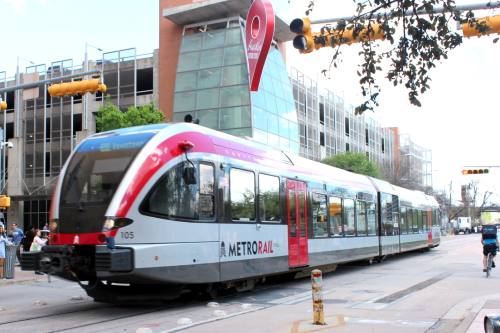Capital Metro unveiled a draft map March 26 outlining future transit corridors in a plan that could go before voters in November 2020 for approval.
For the last two years, Capital Metro has been spearheading the revamp of Project Connect, a regional plan aimed at connecting people and places through high-capacity transit.
During the March 26 board meeting, Todd Hemingson, Capital Metro’s vice president of planning strategic development, discussed the preliminary plan that also will be presented to residents at the Traffic Jam! event March 28 from 4 to 8 p.m. at the Austin Central Library, 710 W. Cesar Chavez St., Austin.
“We are trying to create a true regional vision for Central Texas,” Hemingson said. “What kind of impact can we have, a multigenerational investment. It will not be done in year one. What can we improve what we have and develop new services with people-moving capacity. This is really connecting people and place across Central Texas.”
The draft Project Connect map shows 11 corridors—some with options for future extensions—of locations for future high-capacity transit, such as light rail, commuter rail or bus-rapid transit similar to the agency’s MetroRapid routes. Corridors that are at the top of the list so far include the Riverside Drive corridor out to the Austin-Bergstrom International Airport, the South Congress corridor down to Slaughter Lane and the North Lamar Boulevard corridor up to Tech Ridge.
The regional transit agency is staying mum on which modes it is pitching for each corridor until additional planning can be done on the corridors. This move comes weeks after a preliminary draft of the plan was tweeted out during a joint meeting with a city committee that indicated possible rail lines.
Randy Clarke, who began his role as Capital Metro’s CEO and president March 7, said pulling back on modes to focus on the right corridors was intentional.
“It doesn’t matter what mode we go with if we don’t have a dedicated right of way in a corridor,” he said. “I think that’s saying the obvious, but I really want to make sure the larger community gets more of an understanding and feel for that.”
As part of the planning process, Capital Metro board members also approved a resolution March 26 requesting the city of Austin put up to $15 million on the November 2018 bond for preliminary engineering and environmental analysis work to further study the corridors and modes. The work is estimated to cost between $17.5 million and $22.5 million, and Capital Metro is asking for assistance in funding the next phase of planning.
“That’s really critical to keep the ball rolling, so to speak, in terms of maintaining progress, but we need to provide additional information so if we get to the point where we’re asking for public support in terms of funding for Project Connect, we will have the additional details, the fine-grain analysis done, so we can answer some of the questions that inevitably will arise,” Hemingson said.
In the next few months, Hemingson said staffers will look at how to phase the transit plan, prioritize corridors and pay for it. This step likely will give initial direction on which transit mode might be pursued for each corridor, he said.
“In our phasing and prioritization [phase], we will probably have a bundle of projects that are the ones that we would propose for funding through some kind of public ask in 2020,” Hemingson said.
The estimated ballpark cost of the plan is between $6 billion and $8 billion. Future phases of projects would also require additional voter-approved funding, Hemingson said.








